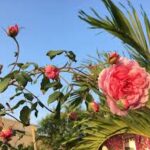
Wildflowers, with their vibrant blooms and ecological significance, are closely intertwined with conservation studies aimed at managing and preserving precious ecosystems, including biodiversity hotspots and rare ecological communities. In this article, we delve into the intricate relationship between wildflowers and conservation research in safeguarding these invaluable landscapes and rare ecosystems.
**1. Biodiversity Hotspots and Endangered Species Conservation:**
Wildflowers often thrive in biodiversity hotspots—regions with exceptionally high levels of species richness and endemism. Conservation studies focused on these hotspots prioritize the protection of endemic wildflower species and their habitats to safeguard biodiversity and prevent species loss. By identifying and conserving key wildflower habitats within biodiversity hotspots, conservation efforts aim to protect endangered plant species and the unique ecological communities they support.
**2. Habitat Restoration and Landscape Connectivity:**
Wildflowers play a crucial role in habitat restoration and landscape connectivity, facilitating the movement of wildlife and promoting genetic diversity within ecosystems. Conservation studies emphasize the importance of restoring degraded habitats and creating wildlife corridors lined with native wildflowers to enhance landscape connectivity and support species migration and dispersal. By restoring wildflower-rich habitats, conservationists aim to reestablish ecological processes, promote species resilience, and maintain healthy ecosystems.
**3. Pollinator Conservation and Ecosystem Services:**
Wildflowers are essential for pollinator conservation and the provision of ecosystem services, including pollination, soil fertility, and pest control. Conservation studies focus on understanding the interactions between wildflowers, pollinators, and other beneficial insects to support pollinator populations and enhance ecosystem resilience. By conserving wildflower-rich habitats and promoting pollinator-friendly landscapes, conservation efforts contribute to the maintenance of ecosystem services critical for agriculture, food security, and human well-being.
**4. Rare Plant Communities and Specialized Habitats:**
Wildflowers are often associated with rare plant communities and specialized habitats, such as alpine meadows, coastal dunes, and serpentine barrens. Conservation studies target these unique ecosystems to identify and protect rare and endemic wildflower species threatened by habitat loss, invasive species, and climate change. By conducting research on rare plant communities and their ecological requirements, conservationists develop targeted conservation strategies to conserve these irreplaceable landscapes and the biodiversity they harbor.
**5. Indigenous Knowledge and Cultural Heritage:**
Wildflowers are deeply intertwined with indigenous knowledge systems and cultural heritage, serving as important sources of traditional medicine, food, and cultural significance for indigenous communities. Conservation studies collaborate with indigenous peoples to integrate traditional ecological knowledge into conservation practices and recognize the cultural importance of wildflowers in indigenous cultures. By respecting indigenous rights and incorporating traditional knowledge into conservation efforts, conservationists promote equitable and culturally sensitive approaches to wildflower conservation and ecosystem management.
**6. Climate Change Adaptation and Resilience:**
Wildflowers are valuable indicators of climate change impacts and play a role in climate change adaptation and resilience. Conservation studies monitor changes in wildflower distributions, phenology, and abundance to assess the effects of climate change on ecosystems and develop adaptation strategies to mitigate its impacts. By promoting the conservation of diverse wildflower species and their habitats, conservation efforts enhance ecosystem resilience and support the adaptation of natural systems to climate change.
In conclusion, wildflowers are integral to conservation studies aimed at managing and preserving precious ecosystems and rare plant communities. By understanding the link between wildflowers and conservation research, we can develop effective strategies to protect biodiversity, restore degraded habitats, and promote sustainable management practices that benefit both wildlife and people. Through collaborative efforts and interdisciplinary approaches, we can ensure the long-term survival of wildflowers and the ecosystems they inhabit.










